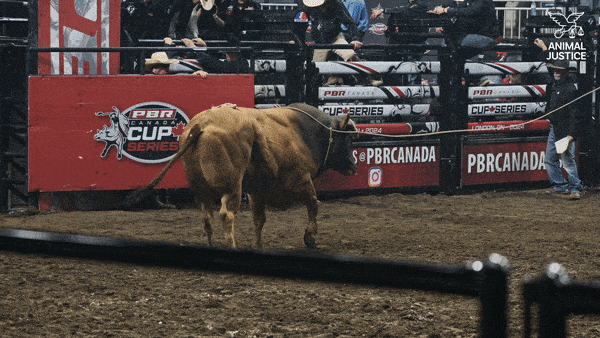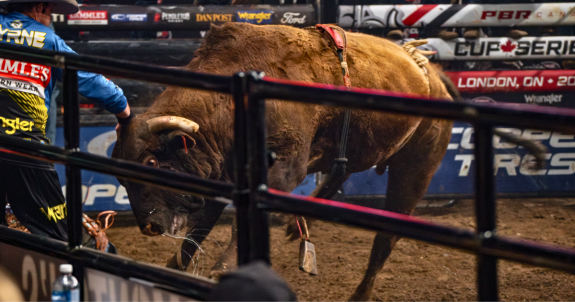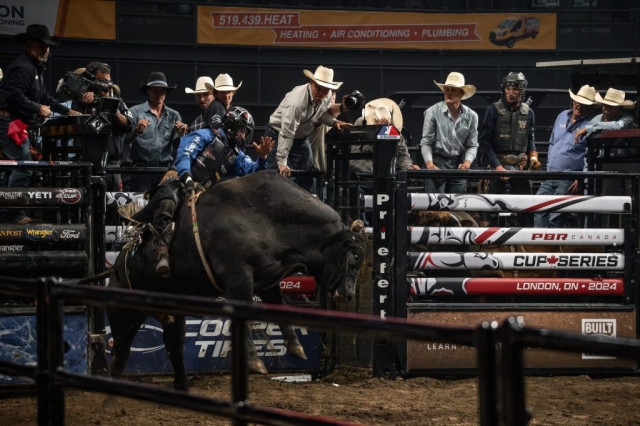Troubling new footage obtained by Animal Justice at a Professional Bull Riders (PBR) rodeo event in London, Ontario, reveals the grim reality of what bulls endure when forced to perform. PBR is the largest bull-riding league in the world, exploiting terrified animals for profit and entertainment internationally. The footage shot at the June 2024 show in London shows bulls abused for rodeo entertainment in front of large, boisterous crowds, including:
- Bulls smacked in the back of the head by riders
- The use of flank straps, tied around bulls’ sensitive underbelly, used to cause discomfort and induce bulls to buck
- Spurs on riders’ boots, digging into the bulls’ skin
- Riders rubbing ropes against the flanks of bulls to agitate them
- Loud pyrotechnics that startled even the crowd
Watch the Exposé
The event begins with loud pyrotechnics that startled the human attendees, much less bulls being held backstage. In the chutes, we saw the riders and their teams agitate the bulls, sometimes smacking them in the back of the head or rubbing rope against their flanks; all while an entertainer riles up the crowd and loud music reverberates through the venue.
When the chute opens, the bulls run out and buck out of a desperate desire not to perform, but to rid themselves of the fear and discomfort caused by the rider. Bucking is an evolutionary response to a predator attack—the bulls are not participating in a sport, they feel like they are fighting for their lives.
“The footage from the London event is troubling for a number of reasons. It is clear that the bulls were subjected to further stressors in order to amplify their fear response.”
– Dr. Malgosia Mosielski, a veterinarian who previously worked in the animal welfare branch of the Canadian Food Inspection Agency
One of these stressors is the use of “flank straps”, which riders tie around the bulls’ sensitive underbelly, just behind their ribcage, to further irritate and distress them. Riders also use spurs on their heels to dig in and grip the bull’s skin, helping the rider hold on and inflicting further discomfort for the bull. When the bulls finally kicked themselves free of the rider, many appeared fearful and rushed around the pen to find a way out. In a moment of desperation, one bull charged a horse while he searched for an exit.

Bull-Riding Violates Animal Cruelty Laws
Prior to this event, Animal Justice formally alerted London Police Service and Animal Welfare Services about the violations of animal cruelty laws that were likely to occur.
There is a dire need for stricter oversight of these events to ensure compliance with the PAWS Act in Ontario, which not only prohibits causing an animal to be in distress, but also prohibits exposing an animal to an “undue risk of distress”. Additionally, because these events are for entertainment purposes only, they likely violate the Criminal Code, which forbids causing unnecessary pain, suffering, or injury to an animal—entertainment is not necessary.
Tools like flank straps, metal spurs, and sometimes rodeo events in general, have been banned in jurisdictions including Pittsburgh, Baltimore, and the United Kingdom, as well as the cities of Vancouver, Port Moody, and North Vancouver. Despite clear animal welfare violations at these bull riding events, the London police and authorities in municipalities across the country have failed to take any enforcement action against PBR.
PBR Bulls Are Forced to Perform Against Their Will
PBR claims that bulls are treated like “elite athletes”, but in reality, these bulls are selectively bred to have heightened sensitivity to negative stimuli, and have no choice in their participation.
PBR typically starts training bulls when they are just two years old, by strapping a 10-pound dummy to their back. They start competing in smaller events at age three with real riders, and by age four they are forced to travel across the country and beyond for competitions. Bulls compete on average for two to four years, though some for as many as 10. After they’re deemed no longer useful in competitions, they are used for breeding until they eventually die at around 15 years of age.
Bulls are Sexually Exploited for PBR
In this industry, straws of “quality” bull sperm are traded much like baseball cards. Similar to the dairy industry, the process of extracting semen from bulls is extremely disturbing.
Farmers sometimes have another animal mount a steer to arouse the bull, then attempt to collect the semen using an artificial vagina. Many bulls are uncooperative, in which case another method is used. The bull is coerced into a chute, and their prostate is stimulated either manually or with an electric probe inserted into their anus, forcing ejaculation. These procedures can be distressing and painful, with bulls undergoing this process two to three times a day, with three to four days of rest in between.

Bull-Riding is Dangerous for Animals & People
It’s not just bulls who are harmed by bull riding. This so-called “sport” also puts human riders at risk, with some participants as young as 19. The PBR glorifies bull riding, drawing young men and boys to the macho culture, money, and adrenaline rush—despite the high risk of long-term health problems like brain damage.
A 2007 research paper found that bull-riding had an injury rate 10 times greater than American football, a notoriously dangerous sport. While football players are required to wear helmets, any PBR contestants born before October 15, 1994 can choose not to wear one.
Ask TSN to Stop Airing Bull Riding Cruelty
A significant factor enabling PBR events to continue is their partnership with TSN, which helps PBR reach a broader audience through its broadcasts and generate substantial revenue. Join us in demanding that TSN end its partnership with the group immediately.





